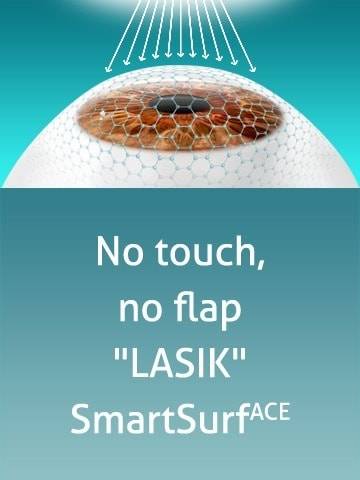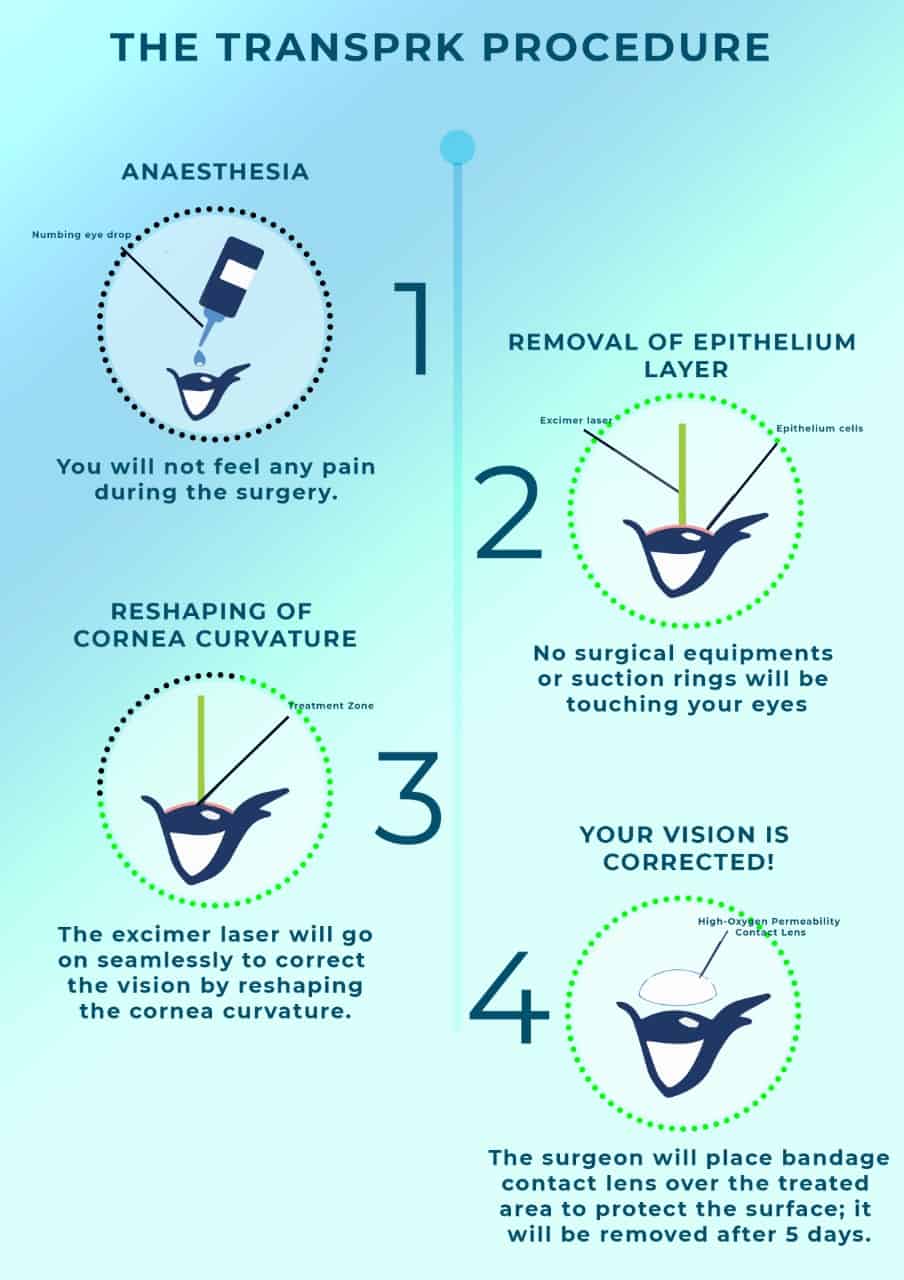
TransPRK (Transepithelial Photorefractive Keratectomy)
TransPRK (transepithelial photorefractive keratectomy) is an advanced touch-free laser refractive surgery that involves the removal of the epithelium of the eye, without suction, flap or blade, or without the use of alcohol. It is used to treat myopia (nearsightedness), hyperopia (farsightedness) and astigmatism and reduces dependency on contact lenses and glasses. It is one of the quickest vision correction procedures and preferred over the LASIK surgery by many as it eliminates the risk of potential flap complications and is suitable even for those with thin corneas and high myopia.
Refractive Treatment

Benefits of TransPRK
Besides being a completely touch-free and non-invasive surface-based procedure, there are also other advantages of choosing TransPRK
Simple and fast one-step procedure, taking only 3-5 minutes for each eye.
The absence of a corneal flap eliminates any flap-related medical condition.
Suitable for those with an active lifestyle, particularly those participating in contact sports.
A safer option for those with high-risk jobs such as air force pilots, military personnel, navy divers and more.
An alternative for those who are not suitable for LASIK due to a thin cornea and high myopia
Minimal risk of dry eye, a common side effect of LASIK eye surgery.
Trans PRK Procedure
It is a simple and fast procedure that utilises the high-tech Schwind Amaris 1050RS excimer laser – the world’s fastest laser machine. This machine is equipped with a zero latency tracker, allowing for safe and accurate treatment.
The procedure does not involve any surgical instrument touching the eye. First, the Schwind Amaris 1050RS laser starts off by removing the epithelium cells. Next, the laser reshapes the curvature of the cornea in a single step to correct refractive power. Once the cornea has been reshaped, a soft contact lens acting as an artificial cornea flap is placed over the cornea to protect it during the healing process.
It takes about 3 to 5 days for the epithelium cells to regenerate. After 5 days, the contact lenses are removed. To facilitate the healing process, patients are required to keep away from strong sunlight and use prescription eye drops for 6 to 10 weeks after the procedure. Full visual recovery typically takes about one to three months.

Patient Testimonials
At Narayana Nethralaya, we are committed to providing our patients with advanced quality eye care at affordable prices. These eye surgery experiences stand testimony to the excellence in eye care that we offer.
FAQ
Frequently Asked Questions
What is the difference between TransPRK, LASIK and Epi-LASIK?
There are many methods to correct your vision – LASIK, LASEK, Epi-LASIK, PRK and now TransPRK. All are widely recognised procedures for correcting myopia and astigmatism.
LASIK is known as the flap-and-zap method. During LASIK, a cut is made across the cornea such that a flap is created either by a metal oscillating blade or a Femtosecond laser. The flap is then lifted, and the laser correction will be applied to the underlying cornea tissue. After which, the flap is closed back without any form of stitches.
Epi-LASIK (Epi is short for epithelium), on the other hand, is a form of ablation where no cut is made to the cornea. During Epi-LASIK, the uppermost surface layer of cells – also known as the epithelium layer – is removed with a blunt oscillating blade made of metal or plastic! Laser correction is then applied to the underlying cornea. As the epithelium cells have regenerative properties, these cells will grow back on its own in 3-5 days. In this way, corneal tissue loss and nerve damage can be better preserved.
TransPRK is even better – there is no oscillating plastic or metal blade. The Excimer laser removes the epithelium by vaporisation and then continues to reshape the cornea all in a one-step, no touch, no blade treatment! This all happens under the guidance of a 7 Dimensional eye tracking system using the SCHWIND Amaris 1050RS Laser.
How do I know if I am suitable for LASIK, TransPRK and/or Epi-LASIK?
You will need to go through an in-depth pre-surgical evaluation. Eye surgeons and optometrists will check your eyes thoroughly. Some of the factors that determine your suitability for TransPRK, LASIK or Epi-LASIK are:
- Corneal shape
- Corneal thickness
- Any pre-existing eye conditions such as glaucoma, cataracts, etc.
Usually, treatments below 75 degrees are rarely done but like in most refractive surgeries, the lower the power, the better the accuracy. The maximum power for safe correction is usually determined by 2 factors:
- Corneal thickness
- Pupil size in the dark.
If I am suitable for TransPRK, LASIK and Epi-LASIK, which procedure is best for me?
You may want to opt for TransPRK over Epi-LASIK or LASIK if:
- You do not want the risk of cutting your cornea (as in Epi-LASIK where the Epi-LASIK blade scrapes off the epithelium).
- You do not want a corneal flap.
- You do not want flap-related complications such as flap infection, inflammation, dislodgement or wrinkles.
- You do not want dry eyes after LASIK (since the corneal nerves are not cut in TransPRK).
- You have an active lifestyle and participate in contact sports such as soccer, rugby, basketball or martial arts where there is a risk of dislodgement of the cornea flap
- You want to better preserve cornea tissue. TransPRK only removes tissue that is absolutely necessary.
How do I evaluate and pick a good eye surgeon?
In TransPRK, Epi-LASIK and LASIK, an experienced and capable surgeon will keep surgical complications to a minimum. TransPRK has a shorter time for surgery. The short surgical time will result in more accurate results. You may also want to check if your surgeon has a good reputation in the community, and if he is committed to his patients before, during and after the surgery.
What happens during surgery?
TransPRK is the most recent and elegant iteration in laser refractive surgery. Your eye will be held open by a speculum and you will stare at a blinking green light straight ahead. The laser will do the rest! Nothing touches your eye and the laser does its magic. With 7th dimensional tracking, the AMARIS laser will direct, predict and recognise a thin layer of your cornea gently. Only the AMARIS family of lasers can perform TransPRK, with the 1050RS having the shortest surgical times.
How long does the surgery take?
TransPRK is the quickest of the laser refractive surgery procedure taking no more than 2 minutes. Epi-LASIK takes approximately 5 to 6 minutes per eye while standard LASIK takes 10 to 15 minutes per eye. Epi-LASIK uses a microkeratome to scrap off the most superficial layer, the epithelium. In LASIK, a flap is cut with a blade or laser. Then, the laser treatment is applied both for Epi-LASIK and LASIK.
Will I be put to sleep during the surgery?
No, the procedure is done completely under numbing eye drops. The eye drops are instilled just before the surgery. You will not feel any pain throughout the short procedure.
What are the risks and complications of TransPRK, LASIK & Epi-LASIK?
Modern TransPRK, LASIK and Epi-LASIK are safe and problem-free in almost all patients. Unfortunately, there is no such thing as risk-free surgery. All surgeries will have the risk of complications such as infections, inflammation and under/over correction. However, such conditions rarely occur. Nevertheless, to ensure a problem free recovery, patients should also do their best by following the doctor’s post-surgery instructions.
Because there is a cut made across the cornea, LASIK has the additional risk of flap complications. These include: flap infection, flap inflammation, risk of flap dislodgement caused by rubbing or a finger poke or sports injury. Another complication resulting from a cut flap is acute and chronic dry eye because of the thousands of tiny cornea nerve endings are being severed in the process of cutting the flap.
Epi-LASIK has the risk of cutting the substance of the cornea. This is because it “peels” away the surface layer (Epithelium) of the cornea using a blunt metal or plastic blade, and then the Excimer laser treats the exposed area.
This is why TransPRK is so elegant. It only removes tissue that is absolutely necessary without any collateral damage. Healing is therefore quicker in TransPRK.
How many days of medical leave will I be given?
You will be given up to 7 days of medical leave, including the day of the surgery itself. Many patients are able to go back to work earlier. However it is advisable not to return to work in the first three days after the operation so as to reduce the risk of infection. You will be prescribed topical eye drops to prevent infection and promote rapid healing.
What are some of the things I should take note of post-surgery?
Rest at home and observe good hygiene for the first week after TransPRK surgery. Avoid crowded, dirty and dusty locations. Do not rub your eyes especially for the first week as the delicate superficial layer is healing under a special (very thin) contact lens. This contact lens reduces discomfort to a minimum and promotes healing. There will be no bloodshot eyes formed in Epi-LASIK and LASIK due to the suction ring. Your vision will be a little misty and cloudy for the first few days but will become clearer every day.
What are my reasons for considering TransPRK Surgery?
There are many types of vision correction surgery. Your surgeon will need to understand why you wish to have corrective surgery. Is it for
· Career reasons
· Lifestyle reasons (sports, leisure activities, etc)
· Cosmetic reasons
· Reduce dependence on glasses and / or contact lenses
Based on the reasons given, your surgeon will be in better position to recommend you the appropriate type of vision correction surgery.
What are the things I should note before TransPRK Surgery?
You will be advised on the following before you come in for your pre-assessment for suitability and before the actual day of the surgery.
- Do not wear soft contact lenses 7 days before your first pre assessment and before surgery.
- Do not wear hard contact lenses (RGPs) 14 days before your first pre assessment and before surgery.
- Do not apply any eye makeup 2 days before surgery.
- Do not apply any perfume on the day of surgery.
- Do not apply any products on your eyes or face on the day of surgery.
- Bring your sunglasses on the day of surgery as you may experience glare after surgery.
- You do not need to fast before the surgery, there is no food restriction.
- Do not drive on the day of surgery.
- Expect to stay for about 2 hours, even though the procedure will only take about 30 minutes.
What to expect after TransPRK Surgery?
Some patients may encounter blurry vision for the first few weeks and may need glasses for reading until their vision stablises. Your eyes may feel sensitive but this can be much reduced with the prescription eyes drops and medication.
You should rest at home after surgery, observe good hygiene and adhere to the following.
For one week:
- NO exercise which gets sweat in your eyes (you can use a sweat band and exercise in a clean indoor gym environment)
- NO water & soap in contact with your eyes
- NO makeup and eye products
- DO NOT rub or scratch your eyes
- Wear sunglasses outdoor
- Eye shields to be worn sleeping/nap time
- Eye drops to be instilled regularly as instructed
It is advisable to avoid swimming for 3 months and use UV Eye protection for a year.
Should I be worried about TransPRK Surgery complications?
With advancing technology, sophisticated surgical skill and optimal patient selection today, the safety and effectiveness of vision correction surgery continues to improve.
Laser eye surgery has successfully treated millions of patients and has high patient satisfaction rates. However, as with any surgery, it has potential complications. It is important for you to weigh the benefits and risks before choosing to go ahead with surgery.
Any side effects and/or complications of TransPRK Surgery?
TransPRK Surgery has a very good safety profile and a very high success rate. However, like any other surgery, there are potential side effects that one should be aware of and must be able to accept a small amount of risk. Proper testing before the procedure can identify patients who are at a higher risk of long-term complications.
There maybe some visual aberrations such as – glare, halos, starbursts, and problems with low-light or night vision, and dryness of the eyes. These are the more common side effects of TransPRK. Most patients experience some of these symptoms immediately after the surgery but they improve as they recover, so most require no treatment.
Dry eyes
This is fairly common and almost all patients experience some degree of dry and gritty feeling during the recovering period. This can be eased with the frequent use of lubricating eye drops.
Night Vision Problems
During the first few weeks or months, one might experience halos, glare and starbursts at night. This condition usually improves with time.
Under-correction, over-correction, or astigmatism
In some cases, corrective eyewear or contact lenses may still be required for the few activities which are more visually demanding. This can be due to the way an individual’s eye responds to the laser, or can be caused by variance in the way each eye heals after surgery. An enhancement procedure may be done in such cases.
Other Risks exceptional to TransPRK
Haze which is a diffuse scarring of the lasered cornea can cause blurring of vision in a few people but this can be prevented with medication and good UV Eye protection after the surgery.
What is the recovery time?
3 days for the wound to close during which one feels uncomfortable. A special bandage contact lens will can be worn overnight for these few days will be placed on the eye to improve comfort and removed when the wound is closed. Clarity of vision returns soon after but can take several weeks in some individuals.
